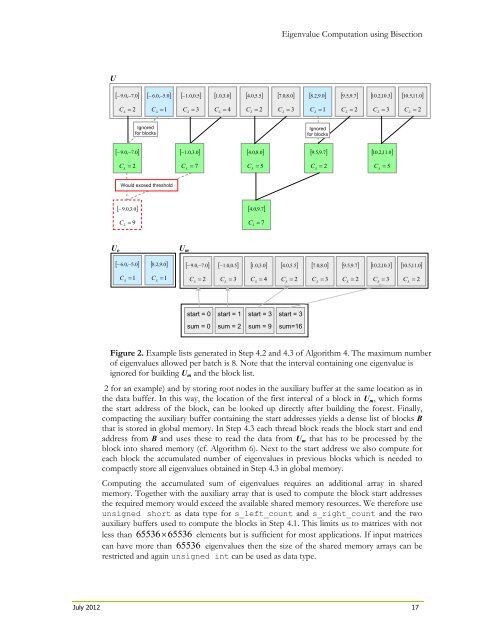Christian Lessig
SORtc
SORtc
- No tags were found...
Create successful ePaper yourself
Turn your PDF publications into a flip-book with our unique Google optimized e-Paper software.
Eigenvalue Computation using Bisection<br />
U<br />
<br />
<br />
9.0,<br />
7.0<br />
<br />
<br />
6.0,<br />
5.0<br />
<br />
1.0,0.5<br />
<br />
<br />
1 .0,3.0<br />
4<br />
.0,5.5<br />
7<br />
.0,8.0<br />
8<br />
.2,9.0<br />
9<br />
.5,9.7<br />
10<br />
.2,10.3<br />
10<br />
.5,11.0<br />
C<br />
<br />
2<br />
C<br />
<br />
1<br />
C<br />
<br />
3<br />
C<br />
<br />
4<br />
C<br />
<br />
2<br />
C<br />
<br />
3<br />
C<br />
<br />
1<br />
C<br />
<br />
2<br />
C<br />
<br />
3<br />
C<br />
<br />
2<br />
Ignored<br />
for blocks<br />
Ignored<br />
for blocks<br />
<br />
<br />
9.0,<br />
7.0<br />
<br />
1.0,3.0<br />
4<br />
.0,8.0<br />
9<br />
.5,9.7<br />
10<br />
.2,11.0<br />
C<br />
<br />
2<br />
C<br />
<br />
7<br />
C<br />
<br />
5<br />
C<br />
<br />
2<br />
C<br />
<br />
5<br />
Would exceed threshold<br />
<br />
9.0,3.0<br />
4<br />
.0,9.7<br />
C<br />
<br />
9<br />
C<br />
<br />
7<br />
U o<br />
U m<br />
<br />
<br />
6.0,<br />
5.0<br />
8<br />
.2,9.0<br />
<br />
<br />
9.0,<br />
7.0<br />
<br />
1.0,0.5<br />
<br />
<br />
1 .0,3.0<br />
4<br />
.0,5.5<br />
7<br />
.0,8.0<br />
9<br />
.5,9.7<br />
10<br />
.2,10.3<br />
10<br />
.5,11.0<br />
C<br />
<br />
1<br />
C<br />
<br />
1<br />
C<br />
<br />
2<br />
C<br />
<br />
3<br />
C<br />
<br />
4<br />
C<br />
<br />
2<br />
C<br />
<br />
3<br />
C<br />
<br />
2<br />
C<br />
<br />
3<br />
C<br />
<br />
2<br />
start = 0<br />
start = 1<br />
start = 3<br />
start = 3<br />
sum = 0<br />
sum = 2<br />
sum = 9<br />
sum=16<br />
Figure 2. Example lists generated in Step 4.2 and 4.3 of Algorithm 4. The maximum number<br />
of eigenvalues allowed per batch is 8. Note that the interval containing one eigenvalue is<br />
ignored for building U m and the block list.<br />
2 for an example) and by storing root nodes in the auxiliary buffer at the same location as in<br />
the data buffer. In this way, the location of the first interval of a block in U m , which forms<br />
the start address of the block, can be looked up directly after building the forest. Finally,<br />
compacting the auxiliary buffer containing the start addresses yields a dense list of blocks B<br />
that is stored in global memory. In Step 4.3 each thread block reads the block start and end<br />
address from B and uses these to read the data from U m that has to be processed by the<br />
block into shared memory (cf. Algorithm 6). Next to the start address we also compute for<br />
each block the accumulated number of eigenvalues in previous blocks which is needed to<br />
compactly store all eigenvalues obtained in Step 4.3 in global memory.<br />
Computing the accumulated sum of eigenvalues requires an additional array in shared<br />
memory. Together with the auxiliary array that is used to compute the block start addresses<br />
the required memory would exceed the available shared memory resources. We therefore use<br />
unsigned short as data type for s_left_count and s_right_count and the two<br />
auxiliary buffers used to compute the blocks in Step 4.1. This limits us to matrices with not<br />
less than 65536 65536 elements but is sufficient for most applications. If input matrices<br />
can have more than 65536 eigenvalues then the size of the shared memory arrays can be<br />
restricted and again unsigned int can be used as data type.<br />
July 2012 17


